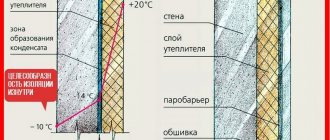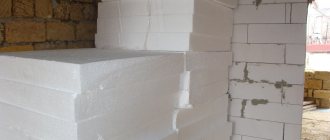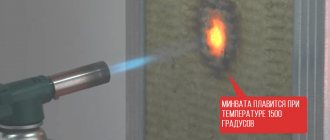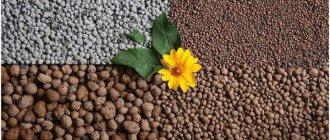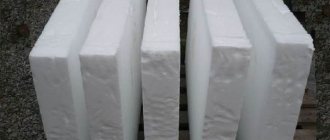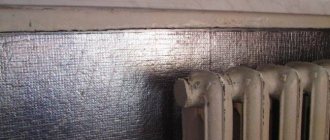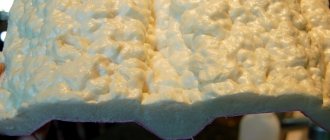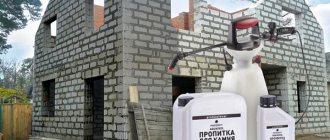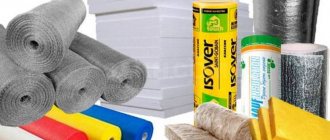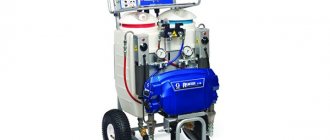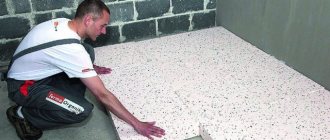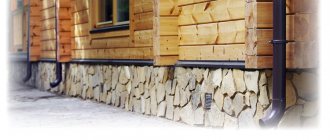Definition
To better understand what polyurethane foam is, we will give a brief definition of the material - it is a synthetic foam with a cellular structure. Refers to a section of plastic filled with a special inert gas, and is often used in construction and manufacturing.
Among the undoubted advantages:
- • long-term use;
- • ease of operation;
- • minimal thermal conductivity;
- • excellent adhesion.
This is one of the high-quality insulation materials that is often used to improve the structural features of a house. Some surfaces are covered with gas-filled polyurethane foam of complex shapes. It has a long lifespan and is easy to use on construction sites.
Polyurethane foam (PPU), composition and properties
It is obtained by mixing two liquid materials:
- • polyisocyanate;
- • polyol.
The substance is whipped, when it hardens, then 90% of the frozen result turns out to be gas. This way the foam can be used for thermal insulation. It stops letting cold and heat through. The final product is structurally different, and the area of use is also different. This depends on the proportion of liquids and additives used.
This is how foam rubber is created - an elastic and soft filler. It is usually used as an interior part for furniture: sofas, armchairs and other upholstered products. The brand depends on two indicators - how dense and hard the foam is.
Density and hardness table
| Brand | Hardness level | How much can you load kg/cm2 |
| ST | Standard. | from 60 to 101 |
| H.L. | Hard. | from 80 to 121 |
| H.S. | Soft. | From 60 to 121 |
| EL | Increased rigidity. | From 60 to 101 |
| HR | Highly elastic. | From 100 to 121 |
| CMHR | Fireproof and highly elastic. | From 100 to 121 |
The presence of a fire retardant impurity turns polyurethane foam into rigid polyurethane foam. It has an increased density - from 30 to 85 kg/cm3. When it is ready, it loses its elasticity. But it has many other useful properties:
- • used to reduce noise levels and thermal insulation;
- • for insulation from foundation moisture, if it is above 70 kg/cm3.
For construction purposes, polyurethane foam is prepared from a couple of components:
- • Isocyanate is the basis of the chemical process, an unchanged component.
- • Polyol – varies depending on the purpose.
Such elements affect the reaction rate, how much foam it will foam, what the density and flammability will be in the end.
GOST 307302-2006 confirms that polyurethane foam has a G3 class - what is it: it is considered fire-resistant, self-extinguishing and flame-retardant.
What is polyurethane foam
A new type of insulation for Russia, polyurethane foam, is rapidly expanding its niche in the construction market. Poor knowledge of the characteristics of the material, aggressive advertising by manufacturers and anti-advertising of competitors have led to the fact that this material is full of myths and conjectures, among which not only ordinary consumers, but also professional builders are lost.
This is what foamed two-component polyurethane looks like.
The problems start with terminology. By polyurethane foam insulation, many understand foam rubber, familiar to everyone from childhood. But this is a soft and very elastic type of polyurethane foam, which can be used to insulate entrance doors in a building, but not structural elements. Real insulation is in liquid form.
But even here, consumers and experts make inaccuracies, considering simple polyurethane foam to be the same as polyurethane foam insulation. At first glance, they are right: both materials are made of polyurethane foam. But there is still a significant difference. PPU insulation consists of two components: “A” - polyol and “B” - polyisocyanate. When mixed, they enter into a polymer synthesis reaction with the release of carbon dioxide. The result is a foamed material with a rigid structure and closed cells. Polyurethane foam can be purchased in barrels or pre-filled cylinders.
Polyurethane foam consists of one component, which, when exposed to air, comes into contact with water vapor (which is why there is a recommendation to wet the surface before applying foam) and polymerizes with oxygen, creating open cells of frozen foam. Hence the completely different physical and technical indicators. To make it clear what we are talking about, we present a table with the main characteristics of the materials.
Table 1. Main indicators of polyurethane foam and polyurethane foam.
| Types of polyurethane foam / Indicators | PPU | Polyurethane foam |
| Thermal conductivity, W/(m×°K) | 0,022-0,035 | 0,025-0,045 |
| Number of closed cells, % | More than 90.0 | Less than 50.0 |
| Change in foam volume compared to the beginning of the expansion process | 1 in 40 | 1 to 70-90 |
| Vapor permeability, mg/(m*h*Pa) | 0,02-0,05 | 0,07-0,17 |
| Density, kg/m3 | 20,0-80,0 | 8,0-18,0 |
| Moisture absorption,% | 1,0-3,0 | 10,0-60,0 |
| Compressive strength, kgf/cm2 | 1,53-10,19 | About 1.02 |
| Bending strength, kgf/cm2 | 3,3-19,37 | About 17.0 |
One type of polyurethane foam is polyurethane foam.
The next myth is that the insulation is new, little studied. Therefore, it is better to give preference to a well-tested, albeit not the best, heat insulator.
Indeed, in Russia this type of insulation began to be used only in the mid-90s of the last century. It is finding its niche with difficulty, since consumers still prefer traditional insulation materials: expanded clay, glass wool and basalt fiber wool.
The late appearance of PPU in the CIS countries does not at all mean that it appeared in the countries of Europe and North America at the same time. There it has been known since the late 30s of the 20th century (invented by the German chemist Otto von Bayer). Today, the lion's share of the insulation market in the USA and Europe is occupied by two-component polyurethane foam.
Varieties
Most enterprises can produce different types:
- • liquid – sold in spray containers;
- • hard – sheets, shells and panels;
- • foam rubber – mats and rolls of finished products.
Thickness and protective properties can vary depending on the purpose. The characteristics allow it to be prepared directly on the construction site. When the proportions of components change, the features change.
Foam rubber
It has a low density from 5 to 35 kg/m3. The scope of application is very wide - from furniture filler to linings in shoes and clothes, they are used to make washcloths and gaskets for doors and windows.
PPU hard
The main place of use is construction. More often it is produced directly on site - this saves resources. Using special equipment, workers mix the components in the required proportions.
This produces ready-made polyurethane foam, which is not afraid of petroleum products and water, but is afraid of organic solvents and other mineral acids. There are more than 30 brands of different purposes and densities. Polyurethane foam can be used in one form for insulation, or in combination with analogues of a different frequency.
The scope of application is wide - from noise and heat insulation of buildings to the insulating layer in refrigeration equipment. Extremely positive reviews.
Liquid
Used for spraying on walls and ceilings. Thanks to its thinner consistency, it became possible to spray it onto walls under pressure to provide insulation. Indispensable if you need to work without weighing down the structure.
Thickness table
| Name | Thickness, cm | ||||||
| 2,0 | 3,0 | 4,0 | 5,0 | 5,0 | 8,0 | 10,0 | |
| Uncoated/paper | 37,8 | 42,6 | 52,2 | 61,2 | 71,2 | 92,3 | 119,8 |
| Foil | 42,7 | 47,5 | 57,1 | 66,1 | 76,1 | 97,2 | 124,7 |
| Armofol | 37,5 | 41,2 | 49,3 | 56,8 | 65,0 | 82,6 | 105,5 |
| On one side - fiberglass | 51,6 | 56,4 | 66,0 | 59,8 | 68,0 | 85,6 | 108,5 |
Types of sprayed polyurethane foam and application technologies
Polyurethane foam is obtained by mixing two components - a diisocyanate and a polyol. Both components individually are toxic, so work is carried out with respirators. By mixing, two toxic substances form a safe polymer - polyurethane - absolutely neutral, which does not react with any substances. Once hardened, polyurethane foam is absolutely harmless and is often used in the food industry.
When two components are mixed, active gas formation occurs - mainly carbon dioxide is released. It is enclosed in the thinnest polyurethane shell, which gives high thermal insulation performance (carbon dioxide is a poor conductor of heat).
The two components are mixed in a special gun under high pressure. To obtain ideal foam, the components must be heated to 45°C (there are heated supply hoses, and there are special heaters). Under pressure, in the form of very fine dust, the components are mixed in a gun and sprayed onto the surface, where they foam and then harden. This is what insulation with polyurethane foam consists of.
Adheses well to any dry surface
To achieve the declared qualities of the material, diisocyanate and polyol must be supplied in equal proportions. Even a slight increase in one or another component negatively affects the characteristics of the material. It’s worse if there is more diisocyanate - such foam quickly “sits”, then collapses, losing its heat-insulating characteristics. If you overdo it with polyol, the picture is a little better - the foam becomes brittle, but it does its job, even though it has a higher thermal conductivity than stated. This is precisely one of the disadvantages of polyurethane foam insulation - the final result very much depends on the qualifications of the workers and the class of equipment used.
It is possible to mix components in given proportions almost perfectly accurately using high-pressure units. Therefore, when choosing a company, you need to pay attention to the equipment that they have at their disposal - with low-pressure installations, you will most likely get non-uniform spraying with poor thermal insulation characteristics.
But different equipment isn't everything. There are also different types of polyurethane foam based on cell type and density:
- Open cell lightweight polyurethane foam. In terms of characteristics (thermal conductivity), it is very similar to mineral wool, with the same main drawback - it is hygroscopic, and at the same time it costs much more than mineral wool. That is, when using lightweight polyurethane foam (density 9-11 kg/m3), you will have to ensure its hydro- and vapor insulation on all sides, and organize a ventilated façade to remove excess moisture. The advantages include higher sound insulation (compared to mineral wool). It is used extremely rarely for insulating external walls and roofs, as it simply does not cope with the assigned tasks - it gets wet and loses its thermal insulation properties. With all that, it costs more than mineral wool. But it is used successfully for insulating internal partitions and ceilings (in combination with all hydro/steam insulating layers), also providing good sound insulation.
- Closed cell polyurethane foam. Regardless of density, it is not hygroscopic, and “adheses” very well to almost any surface, with the exception of polyethylene. There are the following types: Medium density - 28-32 kg/m3. A standard solution when using sprayed thermal insulation on walls, ceilings, and unused roofs. Provides good thermal insulation with a thermal conductivity coefficient of 0.02-0.028 (for air 0.022, lower only for vacuum). Average vapor permeability is 0.05 (comparable to wood).
- Medium density for filling cavities. The characteristics are similar to those described above, but it expands more slowly and hardens only after complete foaming. Used in the construction of layered walls, roofs, etc.
- High density polyurethane foam - 40-80 kg/m3. It is used to insulate existing roofs, under screeds, and in other places with high mechanical load. Due to the higher density, it has a slightly higher thermal conductivity coefficient - 0.03-0.04, vapor permeability is the same - 0.05.
If we talk about prices, the cheapest is lightweight open-cell polyurethane foam. But if we add the need for hydro- and vapor insulation, then in general the price of insulation will not be so low. At the same time, it is still unrealistic to achieve perfect insulation, and it may well turn out that this type of polyurethane foam insulation will be cold. So that you can navigate the prices, we give approximate prices for different types of polyurethane foam (material + labor):
- lightweight with open cell from $180 per cubic meter;
- closed-cell medium density - from $650 per cubic meter.
Insulating wooden walls with polyurethane foam will not cause problems - their thermal conductivity coefficient is the same
Closed-cell polyurethane foam, per cubic meter, is much more expensive, but it does not require any additional layers other than finishing. It is not afraid of water or steam, and performs its tasks for a long time (more than 25 years). The exact price of insulation with foamed polyurethane foam depends on its density and layer thickness, and the size of the sprayed surface. It is considered individually.
Polyurethane foam (PPU) technical characteristics and properties
In terms of thermal insulation characteristics, foam is superior to many analogues. As a heater it is difficult to find equal. High density and adhesion make the cold insulation capabilities even greater. They depend on the structure of the material. The liquid form has a coefficient of 0.019 to 0.035 W/m K, and the closest similar form, mineral wool, has a coefficient of 0.045 W/m K.
Vapor permeability is also low - closed cells do not let steam inside. For mineral wool, the same indicator is 50 times worse. Foam protects walls and ceilings from harmful influences, maintains the desired temperature inside the rooms and stops water particles from penetrating into the walls. But it is not recommended to use it under liquid or in direct contact with it, as this can cause a hydration reaction.
Comparison with mineral wool
This is the closest analogue, more popular, cheaper and inferior in a number of properties. The compressive strength of polyurethane foam is at the level of 0.3; for mineral wool it is not calculated, since it is a very flexible and obedient material.
Polyurethane foam can absorb no more than 10% of water; mineral wool is not designed for such a load and itself has a constant 4% humidity. It will not resist swelling from liquid, so it is not recommended to use it in residential buildings.
Let's talk about maximum service life. The foam will last at least 40 years, and the level of other substances does not exceed 10. Caked mineral wool simply becomes a harmful gasket that is of no use.
Polyurethane foam does not contain dangerous fumes, formaldehydes and phenols, like its cheaper analogue with 6% of unwanted compounds, and is completely safe. It is resistant to aggressive environments and has excellent resistance to rodents and insects. Polyurethane foam does not release fibers into the air; mineral wool contains an allergen for many people and azone-depleting gases.
Table: 12 characteristics
| Property | Index | Explanation |
| Density | 45-60 kg/m3. | Very light material, even mineral wool has 150-250. |
| Shrinkage | — | Was not identified. |
| Compressive strength | 0.46 mm/m. | An excellent indicator, foam concrete has a similar characteristic. |
| Heat conductivity | 0.021 W/m*K. | Mineral wool has 0.035 less than many analogues. |
| Frost resistance | Up to 1000 cycles. | Excellent feature. |
| Water absorption | 2%. | Better than analogues, foam concrete is up to 20%. |
| Vapor permeability | 0,001. | Almost complete insulation from steam, mineral wool has 0.29. |
| Fire resistance | 3G. | It goes out on its own and lights up poorly. |
| Price | 300-1800. | Depends on the thickness, presence and type of protective layers. |
| Sound isolation | High. | Higher than analogues. |
| Toxicity | Not considered toxic. | Can even be used in food refrigerators; there are no harmful fumes or dust. |
| How many years will it last | Up to 50. | It is considered one of the most durable types of insulation. |
Depending on the indicator they are divided:
- • C – self-damping;
- • Vehicles – difficult to burn;
- • TV – flame-resistant.
To increase fire resistance, special substances are usually added to the composition. It is important to know exactly which ones you can put, but it is better to entrust this to specialists rather than do it yourself.
Insulation with polyurethane foam: pros, cons and is it worth it?
A conscientious owner of his own home always considers the issues of insulation of his home to be of paramount importance. And this is an absolutely correct position. Well-planned and high-quality thermal insulation performs several important functions at once. It significantly reduces the heat loss of the building, which makes it possible to create an effective heating system in a residential building with minimal energy costs. Thermal insulation helps well on hot summer days - the house will not be hot, and the air conditioning units will not work with excessive load. And, finally, insulation of all the main elements of the structure is the key to their long-term operation, reducing the level of destructive external influences on the building materials of walls, ceilings, and foundations.
Insulation with polyurethane foam: pros and cons
However, it is also necessary to remember that improperly performed thermal insulation is quite capable of causing serious damage to the building. The choice of insulation materials is an extremely important issue, since not all of them are acceptable in certain cases. Polyurethane foam is considered one of the most promising modern thermal insulators. However. And heated debates do not subside around this material - some consider it a material with virtually no shortcomings, and there are those who subject it to merciless criticism. Let's try to understand this issue - polyurethane foam insulation, pros and cons, by somewhat summarizing and systematizing information from numerous construction sites and forums.
What is polyurethane foam
In the practice of private housing construction, polyurethane foam in our area began to be widely used not so long ago. However, everyone has probably been familiar with this material since early childhood: foam rubber - and this is also one of the varieties of polyurethane foam - was used to make sponges for hygiene procedures, and was also used as stuffing for soft toys or children's furniture.
Foam rubber is familiar to everyone - this is also one of the types of polyurethane foam
Of course, other types of polyurethane are used to insulate building structures, but the basic chemical composition and principle of obtaining the material remain the same. A characteristic feature of all polyurethane foams is their high gas content, reaching 90% of the total volume of the frozen mass.
So, polyurethane foam refers to porous gas-filled polymers based on polyurethane components. Depending on the specific components used, the input can be an elastic, elastic structure (the same foam rubber) or a rigid structure, which is mainly used in thermal insulation measures.
When insulating certain building structures, ready-made thermal insulating polyurethane foam parts can be used, for example, panels, blocks, semi-cylinders (pipe shells), etc. However, the greatest demand is for compositions that are applied to insulated surfaces (or poured into cavities) in liquid form, but have the ability to self-foam and quickly polymerize and harden. Thus, in essence, the preparation of the required composition occurs directly at the site of insulation work.
- For large-scale work, two-component compositions are used. As a rule, modern technology involves using a polyol as component “A”, and polyisocyanate as “B”.
Barrels with components “A” and “B”
Mixing these components with the participation of a small amount of water leads to a polymer synthesis reaction with the active release of gas (in this case, carbon dioxide), which creates a foamed, porous, rigid structure. Such polyurethane foams have a closed cellular structure - the vast majority of air bubbles are completely isolated from neighboring ones.
Closed cell polyurethane foam structure
The thermal conductivity of carbon dioxide filling the cells, all other conditions being equal, is significantly lower, by about a third, than that of air (0.016 W/m×°C versus 0.026 W/m×°C), which is another significant advantage for polyurethane foam with closed cells, precisely as an effective insulation material.
Some professional high-quality systems use freons as a foaming agent.
- At the household level, as well as for carrying out operations limited in area and volume (filling cracks, small openings, carrying out repair work, etc.), one-component polyurethane foam compositions, better known to everyone under the name of mounting foams, are more often used.
Polyurethane polyurethane foams
In fact, the components are already pre-mixed, and the composition required for polymerization is in pressure cylinders. But for the final reaction, foaming and hardening, contact with oxygen in the air and water is required (wetting the surface and water vapor contained in the air). The result is a porous foam structure, the cells of which are open.
The structure of hardened polyurethane foam is not so dense and homogeneous
Expert opinion: Afanasyev E.V.
Chief editor of the Stroyday.ru project. Engineer.
The gas involved in forced foaming, freon, gradually evaporates and is replaced by ordinary air, and such polyurethane foam cannot compete with closed-cell polyurethane foam in terms of thermal conductivity. It also loses in strength and resistance to external influences. Therefore, it is not worth seriously considering such compositions as the main ones for insulating a building - they have their own, and very popular, scope of application. The only criterion by which such an open-cell structure wins is noise absorption and sound insulation.
For comparison, the table below shows the main physical and operational parameters of both types of polyurethane foams:
| Basic parameters of materials | Comparative characteristics | |
| Closed cell polyurethane foam (two-component sprayed) | Polyurethane foam with open structure (spray foam) | |
| Thermal conductivity coefficient, W/m ×°С | 0,019 ÷ 0,035 | 0,025 ÷ 0,045 |
| Number of closed cells | More than 90% | Less than 50% |
| Expansion (rise of foam) compared to the original volume | 1 : 40 | 1 : 70 ÷ 90 |
| Density, kg/m³ | 20 ÷ 200 | 8 ÷ 18 |
| Vapor permeability | 0,02 ÷ 0,05 | 0,07 ÷ 0,15 |
| Moisture absorption | 1 ÷ 3% | 10 ÷ 60% |
| Waterproofing properties | Yes | No |
| Sound absorption properties | good | high |
How to apply polyurethane foam to insulated structures
Since the topic of the article is directly related to thermal insulation measures, in the future we will consider mainly two-component polyurethane foam, which has a closed cellular structure, leaving aside mounting foams.
Prices for sprayed insulation
sprayed insulation
The creation of insulated structures or the imparting of thermal insulation qualities to building elements can be carried out using two different technologies - spraying or filling cavities (pouring).
- Special technological installations are used for spraying. The layout of the complexes may be different, but in any case, the process boils down to the fact that components “A” and “B” are taken from standard containers or built-in reservoirs, pre-filled before starting work. Further, under the influence of the pressure created by the compressor, the components, in transit through the control station, enter the spray gun.
An example of a set of spraying equipment
The mixing of components occurs at the final stage - in the mixing chamber of the gun, and then under high pressure through a nozzle the liquid mixture falls on the surface to be insulated. In fact, the main reaction of polymer synthesis, with the release of heat and a large amount of carbon dioxide, leading to abundant foaming, occurs already on the treated surface.
Their gun nozzles deliver a conical jet of mixed components under high pressure
Both the composition of the resulting polyurethane foam and its application under high pressure contribute to excellent adhesion of the insulation to almost any surface - this is a distinctive feature and one of the key advantages of this material.
Video: insulating walls by spraying polyurethane foam
The control elements of the process plant allow you to precisely regulate the percentage of components in the mixture - the performance qualities of the resulting coating largely depend on this. The outlet pressure and the maximum flow rate of material at the gun nozzle can be adjusted.
Despite the apparent simplicity of the technology, it has a lot of subtleties that only experienced specialists know. Carrying out spraying yourself, even if you can rent a set of equipment, is a difficult task, unless, of course, the priority is the quality of the resulting insulation and the rational use of materials. By the way, many modern so-called “masters” who offer their services in this area also often suffer from low professionalism. Buying your own machine for spraying polyurethane foam does not at all mean immediately becoming a qualified specialist, in direct analogy with the fact that buying a car cannot immediately make the new owner an experienced driver. By the way, in Europe, the operator of a polyurethane foam spraying installation belongs to the category of highly qualified workers; training in this specialty even takes more than one year, and during the course of work, at least once every 6 months, it is considered mandatory to undergo control certification. So, when choosing a contractor to insulate your own home, considerable caution is required - it is better to give your preference to a trusted company that guarantees quality, even if the services are a little more expensive than those from an unknown private owner.
The leader in the production of equipment for spraying polyurethane foam is the American company GRACO, which produces a whole line of special “REACTOR” installations of various capacities. And in the field of production of high-quality component compositions for the production of polyurethane foams, the products of the BASF concern deserve maximum marks. This can also be taken into account when choosing a work manufacturer, having familiarized yourself with its technical equipment.
- The second option for insulating building structures with polyurethane foam is to pour the mixture into cavities specially left for this purpose. A striking example is frame houses built using “sandwich” technology.
This is roughly how filling cavities with polyurethane foam is done.
Such work also requires knowledge of certain nuances and high experience of a specialist. The components are also supplied under pressure, but it is significantly lower than when sprayed on a wall. Mixing is carried out in a special chamber of the gun, from where the mixture is already supplied to the outlet, into the supply pipe. The equipment can be used the same as for spraying, only with a certain reconfiguration of parameters. However, for high-quality performance of work, there are also special filling installations, which provide for the use of special components with options for a kind of “delayed start” of foaming, so that there is enough time to introduce the mixture into the cavity (mold) before the active change in the structure of the composition begins.
To fill the cavity in the building structure, technological holes are left or made in advance
In the structure filled with foam, holes are left or made in advance for inserting the supply tube into the cavity, as well as for visual monitoring of the filling level. The qualifications of the master here are of great importance - you need to have a good understanding of the characteristics of the mixture being prepared: its expected volumetric expansion, the time for full volume expansion and the beginning of hardening. The operator must delicately maintain a balance between incomplete or loose filling of the cavity and possible ruptures or deformation of the insulated structure. Full visual control in such situations is, as a rule, impossible, and the mistakes made can then be identified only during the operation of the building or with the help of special equipment - a thermal imager.
To insulate external enclosing structures, only polyurethane foam with a closed cell structure is used. To create soundproofing barriers in internal walls or ceilings, it is permissible, from an economic point of view, to use cheaper open-cell polyurethane foam.
Video: a clear example of filling a cavity in a building structure with polyurethane foam
Real and far-fetched advantages and disadvantages of polyurethane foam insulation
It's time to talk about the advantages and disadvantages of polyurethane foam used for thermal insulation of building structures. To begin with, we present a table with the main characteristics of closed-cell material declared by manufacturers, and then we will analyze the main parameters in more detail.
| Main characteristics of polyurethane foam | Indicators |
| Compressive Strength (N/mm²) | 0.18 |
| Flexural strength (N/mm²) | 0.59 |
| Water absorption (% volume) | Max. 1 ÷ 3 |
| Thermal conductivity (W/m ×° K) | 0,019÷0,035 |
| Closed cell content (%) | up to 96 |
| Foaming agent | CO₂ |
| Flammability class | B2 |
| Fire resistance class | G2 |
| Application temperature, not less | +10 °С |
| Application temperature | from -150°C to +220°C |
| Application area | Thermal and waterproofing of residential and industrial buildings, tanks, cars, watercraft, carriages |
| Effective service life | 30 ÷ 50 years |
| Moisture, aggressive environments | Stable |
| Ecological cleanliness | After complete polymerization, it is safe. Approved for use in residential buildings. Used in the production of food refrigerators |
| Loss of flow time (seconds) | 25 ÷ 75 |
| Vapor permeability (mg/m×h×Pa) | 0,05 ÷ 0,07 |
| Cellularity | closed |
| Density (kg/m³) | 40 ÷ 120 |
Low thermal conductivity?
Polyurethane foam is rightly considered one of the most reliable thermal insulators. True, at times it is credited with absolutely “fabulous” properties, down to a record low thermal conductivity coefficient of 0.017 W/m×°C.
It’s not even worth talking about 0.017 - it’s simply unrealistic. But the figure of 0.20 is found in publications quite often. Is it really?
It is possible to talk about such high levels of thermal resistance only with absolutely strict compliance with all technology requirements and the use of the highest quality materials and equipment. In a word, such a level is achievable, rather, theoretically. Similar results can only be achieved by using a sprayed system with closed cells, in which the foaming agent is r141b , which in most European countries is simply prohibited for production and use. The density of the created polyurethane foam coating should not exceed 30 kg/m³, which is extremely difficult to achieve under normal conditions.
Freon type r141b is prohibited for production and use in many countries
The thermal conductivity coefficient of 0.022 W/m×°C is a more realistic indicator, but even for this level of thermal insulation it is necessary to strictly follow the spraying technology, with a coating density of no more than 36 kg/m³, and using the same r141b , which is prohibited which has already been mentioned above.
Thus, for example, in Europe, such low thermal conductivity values are not even taken into account - there a thermal insulation coating with a coefficient of about 0.028 W/m×°C is considered high quality. But in reality you can navigate something like this:
- If systems with a closed cell structure and a foaming agent based on a mixture of freons such as Solkane® 365/227 are used, with unconditional compliance with all the requirements of the application technology, then it is realistic to reach a figure close to 0.026 W/m×°C. Unfortunately, in our conditions such systems are practically not used due to their high cost.
- If systems are used in which water is used as a foaming component (the most typical case), then in the best case the coefficient will be 0.030 W/m×°C.
- If low pressure equipment is used, then the polyurethane foam poured into the cavity will ideally have a coefficient of 0.032 W/m×°C.
- When spraying, for reasons of economy, a polyurethane foam coating with an open cellular structure, the lower limit is 0.037 W/m×°C. This, again, is in theory, since the porous structure of such polyurethane foam absorbs moisture quite abundantly, and thermal conductivity in reality can be even lower.
You can upset the reader a little more - often the combination of all circumstances (the use of not very high-quality materials or spraying equipment, violation of technological rules, etc.) leads to the fact that in reality the coefficient increases to 0.040 or even more W/m×° WITH. This, in particular, applies to the advertised “soft” polyurethane foam with an open cell structure.
There is one more nuance. Over time, even in the closed cellular structure of polyurethane foam, diffusion of freon or carbon dioxide occurs with their weathering and gradual replacement with ordinary air. Therefore, the thermal insulation qualities may decrease.
In general, even 0.030 and even 0.036 is a quite decent indicator for a high-quality thermal insulation material. But you still shouldn’t count on an absolutely fantastic 0.020 or 0.022.
Excellent adhesion to all surfaces?
This quality of polyurethane foam is considered to be one of its most important advantages. In many respects we can agree with this, but still with reservations. Not every polyurethane foam has such outstanding features, and it does not “adhere” equally to all materials.
A simple example: normal adhesion to polyethylene will never be ensured. Serious problems cannot be ruled out if polyurethane foam is applied to a completely unprepared base, for example, with remaining whitewash or thin peeling plaster that has not been cleaned from dust and dirt and degreased.
High-quality professional polyurethane foam systems are contraindicated for contact with a wet surface, while open-cell compositions, such as polyurethane foam, on the contrary, even require a certain amount of moisture.
Polyurethane foam does not adhere equally well to all surfaces
It is also absurd to say that polyurethane foam has obviously higher adhesion than any other compositions - there are primers, varnishes and paints that adhere perfectly to galvanized metal, and in the case of spraying polyurethane foam, incidents can also happen here. For example, systems using water as a foaming agent should not be applied to galvanizing - good adhesion will not be achieved.
One more note on this matter - we can talk about high adhesion only if we are talking about closed-cell polyurethane foam. There are known cases when the applied layer of open-cell polyurethane foam simply flew around even under the influence of its not very heavy weight.
The only thing we can completely agree with in this aspect is that the adhesive properties of polyurethane foam are such that the installation of the insulating layer definitely does not require additional materials and fasteners. This advantage is undeniable. But assessing the degree of adhesion is still the job of technologists.
Is the process of applying polyurethane foam thermal insulation quick and simple?
This statement can be called controversial. More precisely, it is better to divide it into two concepts - then it will be easier to “put everything in its place.”
In terms of speed of spraying polyurethane foam, the process is indeed a leader. Of course, there is a certain dependence on the design features of the building, number of storeys, wall configuration, etc. But when compared with any other insulating material, there are simply no competitors in terms of surface thermal insulation rates.
Sprayed polyurethane foam will allow you to insulate very complex structures
As for simplicity, the picture is somewhat different. It has already been said about the qualifications of the craftsmen and the quality of the equipment used and the materials used - there is no smell of simplicity here. Another thing is that spraying technology allows you to easily apply polyurethane foam to the most complex shapes and in the most inaccessible places. At the same time, the process is practically waste-free (with a highly qualified operator), the coating is uniform and seamless, which greatly simplifies subsequent operations, and without “cold bridges” - this increases the efficiency of thermal insulation sharply.
By the way, one of the generally recognized disadvantages of polyurethane foam insulation is precisely the difficulty of performing such work on one’s own.
Very long service life of polyurethane foam insulation?
Again, such a statement cannot be called categorical.
First, we can talk about a long service life only when using polyurethane foam with a closed-cell structure. Those inexpensive open-cell coatings that will be applied from the outside and exposed to the most common atmospheric moisture (even without taking into account the likelihood of direct precipitation) are unlikely to last long. In terms of moisture absorption, they are no better than the same mineral wool, and talking about decades of operation is at least naive.
The most terrible enemy of polyurethane foam is the ultraviolet component of the solar spectrum
Secondly, even if high-quality closed-cell polyurethane foam is used, the ultraviolet component of the solar spectrum always contributes to a reduction in service life. The material undergoes destructuring, becomes brittle, brittle, and begins to succumb to abrasion and weathering. Even the highest quality polyurethane foam systems can lose up to 1 mm of thickness per year due to exposure to sunlight. This is one of the negative qualities of polyurethane foam, and it must be taken into account when planning thermal insulation work.
Third, not very high durability of the material can be caused by an incorrect percentage of components, a violation of the spraying technology (this is often the fault of many “offices” working in this area, using, for example, low-pressure equipment to apply the outer layer to the walls). And this is again an emphasis on the right choice of contractor.
But in general, if all the necessary conditions are met, then we can safely say that polyurethane foam is truly the champion of all wall insulation materials. Evidence of this is the dismantling of old houses in Northern Europe that have served for 50 years or more - the polyurethane foam thermal insulation layers remained intact and retained their basic qualities.
Biological resistance - mold does not appear on polyurethane foam, and mice do not gnaw it?
Again we need to clarify the concepts.
- Let's start with mold and other microflora. Colonies form where conditions are favorable for this. This is high humidity and a certain temperature regime. Thus, if by coincidence the necessary “microclimate” has been created, then mold may well appear on the surface of the material (if we are talking about a closed cellular structure), or even in its thickness (with open cells). This, for example, could be a closed and poorly ventilated room.
At the same time, with high-quality insulation with closed-cell polyurethane foam, the likelihood of conditions for the development of microorganisms is not so high. Inadequate thermal insulation qualities resulting in constant accumulation of condensation cannot be expected when using even a not so thick layer of polyurethane foam, and a closed cell does not accumulate moisture from the air. But the low probability of the appearance of “nests” of mold or mildew is not at all associated with any special antiseptic qualities of the material - everything follows from its basic thermal characteristics. Well, polyurethane foam itself is certainly not a breeding ground for microflora.
- The next issue is the rodent problem. It can be divided into two aspects.
To claim that polyurethane foam becomes an obstacle for them is completely unfounded. Yes, this polymer is absolutely not digested by their digestive system, but it is not any kind of poison. Just like that, of course, a mouse or rat will not chew polyurethane foam - it does not have any nutritional value for them. But if rodents need to make a passage from the street to a home or to a food storage facility, then a layer of polyurethane foam will not be able to stop them.
The polyurethane foam layer will not be a barrier for rodents, but they will not settle in it
Another thing is that in closed-cell polyurethane foam (as well as in extruded polystyrene foam), mice or rats never organize their nests. Rodents willingly settle in mineral wool or ordinary polystyrene foam - the conditions necessary for life and reproduction are easily created there. And any cavity in PUF or EPS is a chamber impenetrable to air and moisture, in which normal heat exchange and long-term stay are impossible.
Conclusion - polyurethane foam will not be a barrier for mice or rats, but it will not be a habitat either. Let us repeat - this applies to closed-cell polyurethane foam. In the open-cellular structure, nothing will prevent mice from building their warm and cozy “palace”.
Is polyurethane foam an absolutely environmentally friendly material?
This statement is very close to reality. If you “look around”, you cannot help but see that polyurethane foam is used in everyday practice almost everywhere, including in conditions of constant contact with the human body, with food, with medical equipment, etc. Isn't this an indicator of environmental friendliness?
But here an extremely important caveat follows - all this will be fair if only high-quality components were used during spraying (pouring), professional equipment was used, and the work itself was carried out by a truly qualified craftsman. The fact is that the initial components are toxic and belong to hazard groups II and III, which after mixing, reaction and polymerization are converted into completely safe polyurethane foam. However, low quality of the initial compositions, incorrect proportions of supply to the mixer, and other violations of technology can shift the required balance, unreacted components remain, and the resulting spraying can “acquire” very toxic properties in one direction or another. The negative reviews about polyurethane foam found online, that it emits a pungent odor that causes illness, are 100% likely caused by precisely these circumstances.
Really high-quality polyurethane foam can be considered an environmentally friendly material
Another thing is that the spraying process itself requires extremely responsible safety measures. Work must be carried out in special equipment, with mandatory protection of all exposed skin and mucous membranes. Particular attention is provided to ensure respiratory protection. According to existing technological requirements, fully closed masks with a forced supply of clean breathing air must be used for this purpose. By the way, this is another criterion for the conscientiousness and qualifications of the craftsmen. If it is noticed that workers carry out spraying in ordinary clothes, and of all the protective equipment they use only a gauze bandage, this is definitely a “scavenger hunt”. If their manager does not care about the health of his employees, he is unlikely to have a “headache” about the quality of the insulation being performed.
Very often, the most environmentally friendly materials are presented as natural insulation materials - such as moss, sawdust, flax tow, straw, etc. Everything seems to be correct here, except for one thing. Specifically, such materials become a rich breeding ground for microorganisms and insects, and actively absorb a variety of substances from the surrounding air, which may well pose a danger to human health. High-quality closed-cell polyurethane foam does not have such disadvantages.
One can immediately note the chemical resistance of polyurethane foam to the vast majority of substances used in everyday life. He is not afraid of solutions of acids and alkalis (except highly concentrated ones). Unlike, say, even extruded polystyrene foam, it can be decorated with any plaster compositions and paints on any basis.
Does using polyurethane foam eliminate the need for vapor and waterproofing?
This advantage is valid only for closed-cell polyurethane foam. Indeed, in both the roofing and wall “pie” (when the material is externally sprayed onto the walls), there is no need to use internal water vapor barrier and windproof waterproof membranes. And this, I must say, is a very significant simplification of the entire overall work process and a significant saving effect.
However, it should be borne in mind that this is not always for the good. On the Internet, for example, there are constantly heated debates regarding the vapor permeability of materials. According to the “classical” scheme, it should increase from the inside of the premises towards the street - this ensures the free removal of water vapor and reduces the likelihood of condensation forming in the thickness of the wall structure. The use of polyurethane foam can disrupt this pattern. In order for the room insulated from the outside to remain within the normal temperature-humidity balance, special attention will have to be paid to ventilation issues, or to provide interior decoration that would prevent the penetration of vapors through the walls from the inside.
Insulating a wooden frame with polyurethane foam is a very dubious undertaking
Spraying polyurethane foam onto a natural wooden frame is not particularly welcome, especially one that has recently been erected, the logs in which have not yet had time to free themselves from excess moisture. If you look at the vapor permeability table, the indicator for sprayed polyurethane foam and coniferous wood across the fibers is approximately the same, about 0.05 mg/m×h×Pa. Under certain conditions, a polyurethane foam “coat” can “preserve” moisture in the wood, and this is dangerous due to the occurrence of putrefactive processes. But for wood composites (plywood, OSB, chipboard) polyurethane foam is safe - its vapor permeability is even higher than theirs.
But polyurethane foam with an open cellular structure is practically no different in this regard from other insulation materials. When using it, the use of water and wind protection will become a prerequisite.
Is the material fire resistant?
It must be said right away that technologists have not yet succeeded in creating completely non-flammable polyurethane foam. With polymers, this is generally an extremely difficult issue simply due to their molecular structure and component composition. Another thing is how flammable it is and to what extent it is dangerous in the event of a fire.
If the owner of the house chooses inexpensive material from some eastern manufacturer, then this is most likely G-4 class polyurethane foam. It should be noted that this class includes everything that burns. In such compositions, no flame retardant additives are used at all, or their concentration is frighteningly low. One can say unequivocally about such material - it burns “quite decently”, and extinguishing it becomes a very difficult task. And it not only burns, but also becomes a flame spreader. Unfortunately, modern history is full of cases when, for example, polyurethane foam spraying caught fire due to welding work and burned out completely, which led to deformation and destruction of even strong wall structures. Thus, by purchasing an incomprehensible material from an unknown manufacturer, the owner, to some extent, “lays a mine” under his own home.
Polyurethane foam cannot be classified as non-flammable materials
Since the “NG” class is still an unattainable horizon, technologists are trying to minimize the flammability of polyurethane foam by introducing special additives. Most high-quality compositions can already be classified as category G-3 - the material will not ignite on its own without exposure to an open flame. When the source of fire disappears, the polyurethane foam extinguishes and cokes, preventing the flame from spreading further. Unlike expanded polystyrene, it does not melt and does not flow. Smoldering of the coked material is possible, but even under these conditions the combustion products are not as toxic as when burning polystyrene foam, although they also pose a very serious danger to human health and life.
There are also more fire-resistant varieties of polyurethane foam, which are classified as G-2 and even G-1. However, they have not yet received wide distribution. Their insulating qualities are lower, and the cost is approximately 3–4 times higher than that of popular G-3 class systems.
By and large, the degree of fire safety of the entire building depends only to a small extent on the type of insulation - usually this indicator is based on the correct structure of the wall and roof structures. And high-quality polyurethane foam, even class G-3, can play a rather positive role here.
Consequences of the fire - polyurethane foam prevented the fire from spreading
For example, the photograph shown shows the consequences of a fire that occurred in the room above. The sprayed polyurethane foam on the ceiling burned out and coked, but did not transmit the flame below. At the boundary of the ceiling with the wall and on the upper part of the wall, the material was only touched by thermal decomposition, and below it generally remained intact. In addition to, in fact, low flammability, this was also facilitated by the extremely low thermal conductivity of the material - it does not contribute to the spread of the high temperature necessary for the occurrence of a flame.
So, the publication quite objectively, from the author’s point of view, examined the main properties of polyurethane foam used as insulation. Having become familiar with the advantages and disadvantages of this material, having studied the possibility of inviting truly qualified specialists with high-quality component systems and classy equipment, having roughly calculated the “accounting” of the upcoming work, it will be possible to make a decision. If the arguments seem unconvincing, you have every right to choose any of the other insulation materials suitable for this design.
Variety of insulation materials
A comparative analysis given in a special article on our portal will help you choose the right insulation material for thermal insulation of external walls
Calculator for calculating the thickness of the insulating layer
And one more help to the reader - the special calculator located below will help you quickly evaluate and compare the effectiveness of insulation and accurately calculate the required thickness of the thermal insulation layer on the wall.
To use it, you must first find the value of the required heat transfer resistance, calculated for a specific region. It is indicated on the diagram map below. The purple numbers are taken into account - for walls and enclosing structures.
Map diagram with the values of the required heat transfer resistance by region of Russia
After this, all that remains is to enter the requested values and indicate the planned or existing parameters of the wall structure (if the external finishing is made according to the principle of a ventilated facade, it is not taken into account). The program will perform all other calculations itself.
Go to calculations
The required insulation thickness is 132 millimeters. If a negative value is obtained, then insulation is not required
Beneficial features
Like any other material, foam has its advantages and disadvantages.
Advantages:
- • Lightness. Used in attics, roofs, light buildings. Doesn't make the structure heavy.
- • Does not require fastening elements or additional parts.
- • There are no “cold bridges”. Seamless thermal insulation.
- • Quick to apply. There is no need to prepare additionally or spend hours near the construction site.
- • You can work with the material at temperatures from -200 to +200 degrees.
- • Withstands changes in temperature and humidity, resistant to frost and heat.
- • Does not react to most alkalis, acids and salts.
- • Excellent surface grip.
In liquid form it is suitable for filling voids. Fills spaces between walls without dismantling ceilings - it simply pours into the hole.
Calculation of material thickness
During such calculations, a huge number of factors are taken into account, for example: what climate zone do you live in, the average annual temperature inside the room, what will this room be used for, what exactly do you plan to insulate, the desired temperature, ambient humidity and many more similar ones. However, experts have derived average values for each specific object.
Below are the most popular objects:
- Roof, attic. The layer should be in the range of 12-15 cm, and have a material density of at least 40 kg/m3.
- Floor, basement. Layer 6-7 cm, density 40 kg/m3.
- Foundation, thickness 4-7 cm, density should be more than 55 kg/m3.
- Wall, thickness 5-7 cm, layer 40 kg/m3.
If you live in the northern region and have fairly severe winters, it is better to take the extreme range with a margin of 10%.
Minuses
Let's talk about what polyurethane foam looks like. It is a hardened foam with or without small pores, depending on the type of mixing. But it also has disadvantages:
- • Does not withstand constant exposure to ultraviolet radiation. It is necessary to protect from direct sunlight. The covering should be attached on top.
- • Apply only to dry and warm surfaces. Before application, the wall or floor should be cleaned of debris and rust to enhance adhesion.
Does not burn, but can smolder when exposed to high temperatures. Thermal insulation will deteriorate, so it is not recommended to use it in baths, saunas and stoves.
PPU material: what is it for health?
When the foam has hardened and is in the wall, it does no harm. But during the production process, all safety requirements must be observed. You cannot mix components without:
- •masks;
- • respirator;
- • protective suit.
Helpful Tips:
- • reagents must be tested and certified;
- • place – not blown;
- • equipment – high quality.
If all conditions are met, the foam will be safe.
How to install
One of the most common methods is spraying. Using this method, the material holds well and is used economically; it is suitable for structures with complex geometry, protrusions and recesses. For the process to be successful, you need to:
- • Make sure that the wall or other surface is dry.
- • No high humidity, rain, hail or snow.
- • The wind does not exceed weak 5 m/s, and it is better to protect the work area from it.
- • Make sure that the coating area is warm - not lower than +10 degrees.
- • Heat the mixture - about +18-25 degrees at the time of application; cold is difficult to work with and does not hold well.
- • Apply a layer of no more than 3-5 cm, if thicker is required - in 2-3 steps after drying.
The room must be ventilated. The person should wear a special suit, mask and respirator. Start with difficult areas: pipes, convex or concave parts, ventilation hatches or electrical distribution boxes.
Helpful Tips:
- • It is recommended to apply the composition in several layers. This way the effect will be more significant and adhesion will be higher. It is important to ensure that the previous layer is completely dry. Especially significant on walls with signs of destruction. Here it will lie unevenly and will require 2-3 additional sprayings to even out the area.
- • Before purchasing, you should consult with a specialist to choose the right brand of polyurethane foam with the required impermeability. This will save money and time spent on repairs. You can purchase high-quality, high-strength material.
- • If you apply polyurethane foam taking into account all the requirements and advice, then a coating will appear on the surface that will last for many years and will perform its tasks until the end of its service.
This material is used to insulate the foundation and external walls if necessary. It is also used to treat main pipes to retain heat in them. Mounted on balconies and loggias, used inside toys and sponges for washing dishes. This is a large part of production, which is involved in various fields. It’s easy to purchase, and it’s easy to apply. The result is of high quality and retains its beneficial properties for many years if handled correctly.
Spray insulation technology
At first glance, the work methodology seems simple and understandable. However, to do the job well, you need relevant experience. It is important to set up the equipment correctly , calculate the optimal spray thickness and evenly treat the surface.
Tools and equipment
To operate, you will need a low or high pressure electro-pneumatic installation. As a rule, the kit already includes hoses and a spray gun. Consumable tanks must be ordered additionally.
When choosing equipment for insulating a frame house with polyurethane foam, you need to take into account a number of parameters:
- Possibility of heating the composition. The operating temperature for the chemical reaction of the components is +20-25°C; when lowered, the polyurethane may thicken - this will increase consumption and reduce the quality of the coupling.
- Mobility and compactness. This quality is especially important when performing high-altitude work.
- Performance. To process large areas, it is not advisable to purchase or rent a low-power unit.
In addition to equipment, you will need protective equipment : a respirator or gas mask, cotton or rubber gloves, shoes, overalls, goggles, overalls.
Calculation of insulation thickness
It is better to entrust calculations to specialists. When calculating the thermal insulation layer, many parameters are taken into account:
- type and thickness of building material;
- type of structural element: wall, roof, ceiling, etc.;
- thermal conductivity coefficient of building material;
- climatic conditions of the region;
- qualitative characteristics of the polyurethane foam itself: type, density.
Average insulation thickness values for the central region of the Russian Federation when using polyurethane foam with closed cells:
- walls – at least 50 mm;
- roof, attic – 120-140 mm;
- basements, floors – 50-70 cm;
- foundation – 30-70 mm.
Preparatory activities
Before applying the solution, the walls of the house must be cleaned and dried - residual dirt, dust and other debris will interfere with the normal adhesion of the foam to the surface. Check the integrity of the coating; dents and cracks with a diameter of more than 5-6 mm must be removed. They must be covered with cement mortar.
The next step is to install the frame for the upcoming cladding. Make a sheathing from a wooden beam or metal profile. The frame posts must be placed strictly vertically and have a single plane.
Useful: Chipboard finishing: technology and scope of application
If on the day chosen for work there is high humidity or there is rain in the forecast, then the “foam” treatment must be postponed to another time. Optimal conditions are a sunny but not hot day, the surface temperature should not exceed +30°C.
Spraying polyurethane: step-by-step instructions
The preparation of the composition depends on the form of its release. Polyurethane foam in cylinders (Polinor) is ready for use. The container must be placed in the mounting gun and shaken well.
Two-component mixtures sprayed under pressure require special preparation:
- Mix the first mixture with a mixer.
- Shake the second element (hardener) well.
- Combine the components according to the instructions, usually the proportion is 1:1. When preparing, you must avoid getting debris and moisture into the mixture.
- Fill the tank with the finished product to feed into the spray gun.
Rules for spraying polyurethane foam:
- First of all, foam is applied to hard-to-reach areas: areas near the chimney, ventilation holes, walls of complex configuration.
- Each subsequent layer of polyurethane foam is sprayed only after the previous one has completely hardened.
- It is advisable to complete all work in one day. For large processing areas, you need to enlist the help of an assistant.
- The maximum thickness of one layer is 15 mm, the minimum number of coatings is 3.
- Areas that do not require thermal insulation must first be covered with dense material.
- Polyurethane foam is applied from bottom to top, the composition is distributed between the elements of the sheathing.
